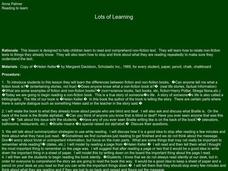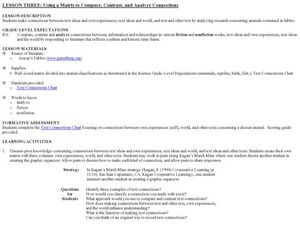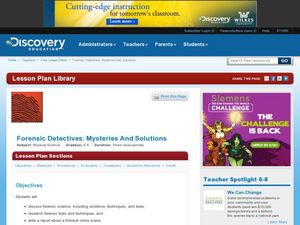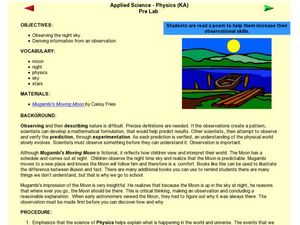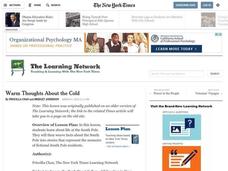Curated OER
Reading to Learn
Children learn to read and comprehend non-fiction text and explore how to relate non-fiction texts to things they already know. They then examine how to stop and think about what they are reading repeatedly to make sure they understand...
Curated OER
Enrichment Activities - "Mrs. Frisby and the Rats of NIMH"
Fifth graders read the novel "Mrs. Frisby and the Rats of NIMH." They discuss the various characters in the book, and the different types of conflict that take place within the book. They also research owls and rats to make comparisons...
Curated OER
My Biotic Creation
Eighth graders explore different ecosystems. In this ecosystem survival lesson conditions lesson students create their own fictional creature.
Curated OER
On Market Street
Second graders study basic facts about consumers and consumer goods. The book "On Market Street" is used in this lesson.
Curated OER
Using a Matrix to Compare, Contrast, and Analyze Connections
Young scholars explore writing techniques by comparing fiction vs. non-fiction. In this literature analysis lesson plan, students read stories from Aesop's Fables and compare the themes and characters to stories from their own life....
Curated OER
Forensic Detectives: Mysteries and Solutions
Middle schoolers examine forensic science. In this video based lesson, students examine the tools and techniques of forensic science. They write a report about a fictional crime scene from the Discovery video.
Curated OER
Rainforest Introduction
First graders explore world geography by completing a KWL chart. In this rainforest research lesson, 1st graders read a fictional story discussing a boy who lives in the rainforest. Students analyze the story, identify the plot and...
Curated OER
Lunar Field Trip
Learners take a virtual tour on Google Moon of what human life would be like on the moon. In this moon lesson plan, students also compose web diagrams, make charts, make a time line, investigate problems, and more.
Curated OER
Life Beyond Earth
Students investigate the solar system and what makes a planet habitable. They complete an online Webquest, simulate a NASA training program online, take an online quiz, answer discussion questions, and locate newspaper articles about the...
Curated OER
Alas, All Human
Students define a scientist. In this ethics and science instructional activity, students read Asimov's Alas, All Human and write responses and discuss the possibilities of imperfection within science by scientists. Students discuss what...
Curated OER
Poetry and Observations
Students compare poetry and the night sky. In this poetry lesson, students read poetry and compare the imagery from the poem with the night sky. Students explore how science and poetry relate to one another.
Curated OER
Africanized Honey Bees And Society
Students investigate how information is disseminated about honey bees and other insects. They make a list of key words and phrases, or even write a brief summary of their impressions of insects and their relatives after viewing the movie.
Curated OER
Someone Like Me
Students investigate what sort of person the author is. They listen as the teacher use her notes to introduce Tom Holt briefly. Students are asked if anyone has read any of his books. They work in pairs to find more about Tom Holt as a...
Curated OER
Butterflies, Butterflies, Butterflies
Transform your class into a butterfly museum! Research different types of butterflies, their habitat, and life cycle. Interactive components such as PowerPoint presentations, Claymation movies, and webpages add pizzaz to the museum...
Laboratory for Atmospheric and Space Physics
Space Travel Guide
Looking to take a trip? Why not go to space? Here, scholars take on the role as travel agent to create a guide to their favorite planet including travel tips and sightseeing recommendations.
Curated OER
Warm Thoughts About the Cold
“What do you think life is like at the South Pole?” After responding to this journal prompt, class members read and discuss the New York Times article, “At South Pole, New Home for a New Era.” Using resources available from the Times’...
Curated OER
Come Fly with Me . . . Open a Book: Travels through Literature
This detailed overview of a curriculum unit suggests using travel literature to engage and stimulate your third graders’ interest in reading. The suggested reading list includes fiction and non-fiction materials and offers urban children...
Curated OER
Phineas Gage: Concept Analysis
Prepare for teaching Phineas Gage: A Gruesome but True Story About Brain Science with this written analysis of the book. The analysis includes a summary, considerations for teachers, project ideas, and a list of additional resources that...
Education Development Center
Rational Exponents
It's rational to root for your class to learn about exponents. Scholars study rational exponents by reading a fictional dialogue between classmates. They analyze the conversation to understand the connection between rational exponents...
Curated OER
Christopher Columbus: The Man, the Myth, the Legend
Learn more about maps by examining Christopher Columbus's voyage to the New World. Kindergartners will learn about basic map skills and how to identify the compass rose, oceans, and land masses. They will also discover the purpose of...
Curated OER
Tell Us All: Tools for Integrating Math and Engineering
What a scam! Middle and high schoolers pose as journalists exposing consumer fraud. In this lesson, they write an article for a magazine using data collected during previous investigations (prior lessons) to defend their findings that a...
Curated OER
Romanticism 1800-1860
What do Roger Chillingworth, Dr. Heidegger, and Ethan Brand have in common? They are all American literature poster boys for Romanticism, advertising the dangers of valuing reason over feeling and intuition. Introduce your class to...
Curated OER
Summarize This!
Students explore how to summarize a reading passage. They read non-fiction books. Students use a Venn Diagram to compare and contrast the two animals they read about. They write a summary using the information in their Venn Diagram.
Curated OER
Under The Sea
In this resource lesson plan, students use non-fiction books to research ocean animals. Students discover the many features of non-fiction books and how to use these features to help them conduct research. Students then categorize...
